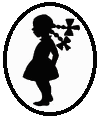

Girls until the 1970s wore skirted garments to school, primarily dresses or blouses and skirts to school. They still do, but no longer exclusively. Girls only wore skirted garments in the 19th century. And this continued for much of the 20th century. Many European girls wore smocks to school, over smocks and dresses. This began in France as a Republican measure to reduce outward appearances based on family income among school children (1870s). Many other countries on the Continent, especially Italy, adopted smocks as a school garment. Pants of any kind were not seen appropriste for girld to wear to school. While this is no longer the case, actual school uniforms still are mostly dresses or skirts. The girls school uniform dresses are both solid colors and patterns--almost always plaid. Perhaps the most destinctive girls' school garment was the gym slip--a British innovation. It was normally worn with a white blouse. The gym slip is a skirted garment intermediate between a skirt and a dress. The gym slip had a bodice like a dress, but like a skirt had to be worn with a blouse. While the gym slip originated in Britain, we now see it being worn around the world. In some countries it is more common than in England. At non-uniform schools in recent years girls have begun wearing pants, both jeans and shorts. Pinafores were common in the 19th century, a protective garment at a time that clothing was relatively expensive and doing lundry was laborious. Pinafores rapidly disappeared after the turn-of-the 20th century. An exception was Soviet girls who commonly wore starched white pinafores with dresses into the 1980s.
Pants of any kind were not seen appropriste for girls to wear to school. While this is no longer the case, actual school uniforms and schoolwear garments still are mostly dresses or skirts. At non-uniform schools in recent years girls have begun wearing pants, both jeans and shorts.
Girls wore a wide vvariety of dresses to school. Here we see Yugoslav girls in the 1930s wearing plin black dresses as a uniform with white collars a kind of decoration (figure 1).
Pinafores were common in the 19th century, a protective garment at a time that clothing was relatively expensive and doing lundry was laborious. Pinafores disappeared after the turn-of-the 20th century. We still see pinafores in the 1900s decade, but they rapidly disappeared after World War I. A good example is like a Dutch school group in 1902. It looks to some kind of private school group. An exception was Soviet girls who commonly wore starched white pinafores with dresses into the 1980s. The older girls began to rebel before the Soviet Union imploded.
Many European girls wore smocks to school, over smocks and dresses. This began in France as a Republican measure to reduce outward appearances based on family income among school children (1870s). Many other countries on the Continent, especially Italy, adopted smocks as a school garment.
The girls school uniform dresses are both solid colors and patterns--commonly checks and plaids.
There were several styles that were particularly popular st achools.
Perhaps the most destinctive girls' school garment was the gym slip--a British innovation. It was normally worn with a white blouse. The gym slip is a skirted garment intermediate between a skirt and a dress. The gym slip had a bodice like a dress, but like a skirt had to be worn with a blouse. While the gym slip originated in Britain, we now see it being worn around the world. In some countries it is more common than in England. We se it being weirn as both a unifgorm and elctiv clothing item.
We also notice British girls wearing light colored frocks during the summer. They were often done in checks. This was acpopular unoform cvjice durung the summer.
Another popular style was sailor outfits. This was usually a style girlsselected to wrear in non-uniform schools, but some countries had schools with sailor uniforms, most prominently in Japan. We note both sailor dresses and sailor blouses/skirts.
Navigate the Boys' Historical Clothing Web Site:
[Return to the Main girls' school specific garment page]
[Return to the Main girls' school garment page]
[Return to the Main girls' school uniform page]
[Return to the Main girls page]
[Return to the Main school uniform page]
[About Us]
[Activities]
[Biographies]
[Chronology]
[Color]
[Countries]
[Difficult images] >> combine w/ photo interprtation
[Fashion]
[Families]
[Garments]
[Gender conventions]
[Hair]
[Literature]
[Photo intrpretation]
[School]
[Sisters]
[Return to the Historical Girls Clothing Home Site]
